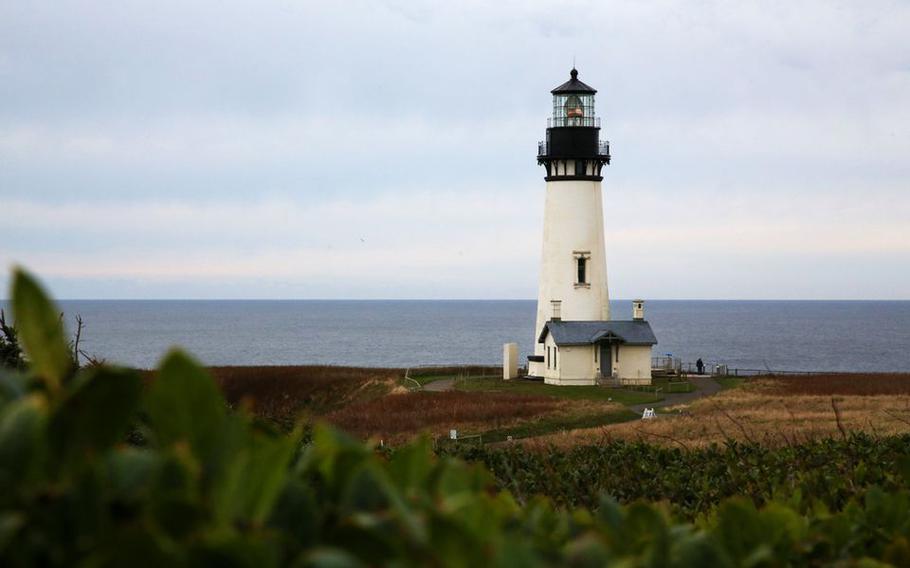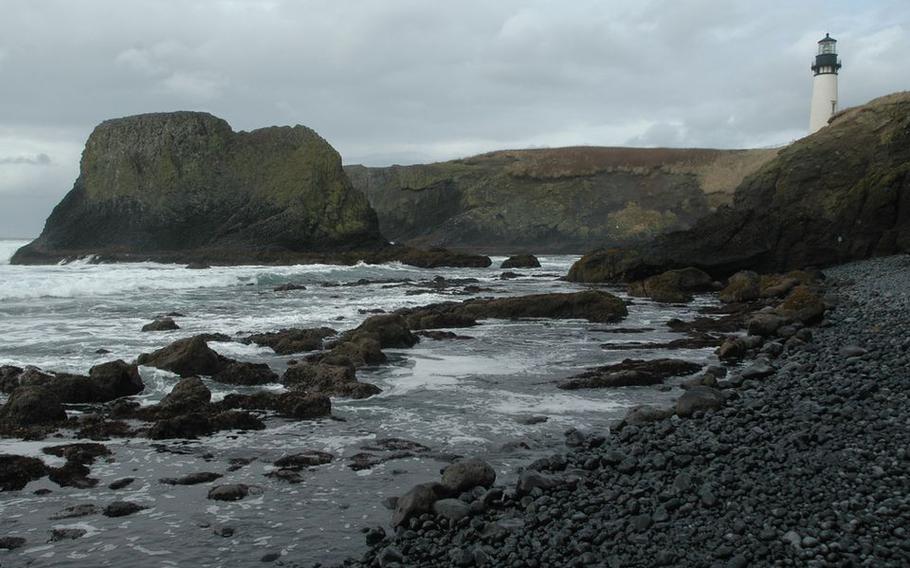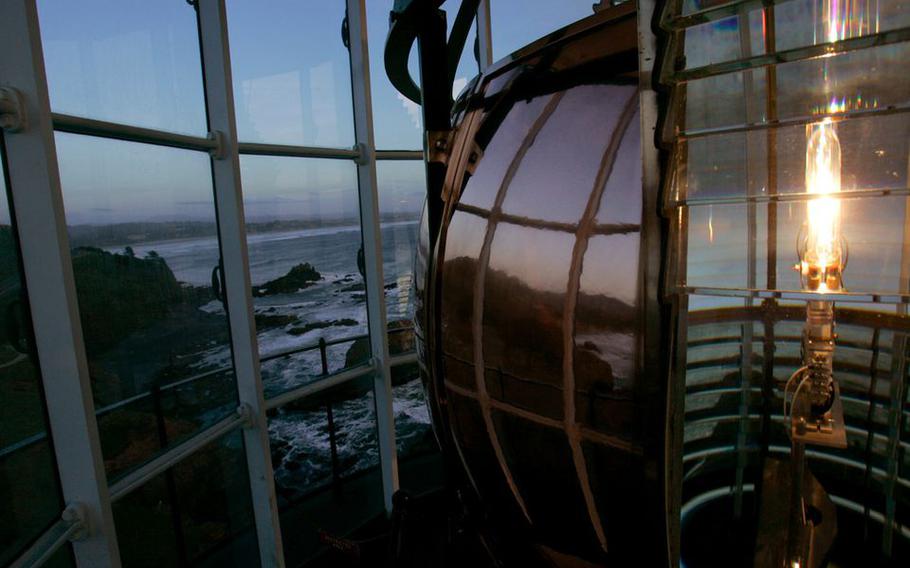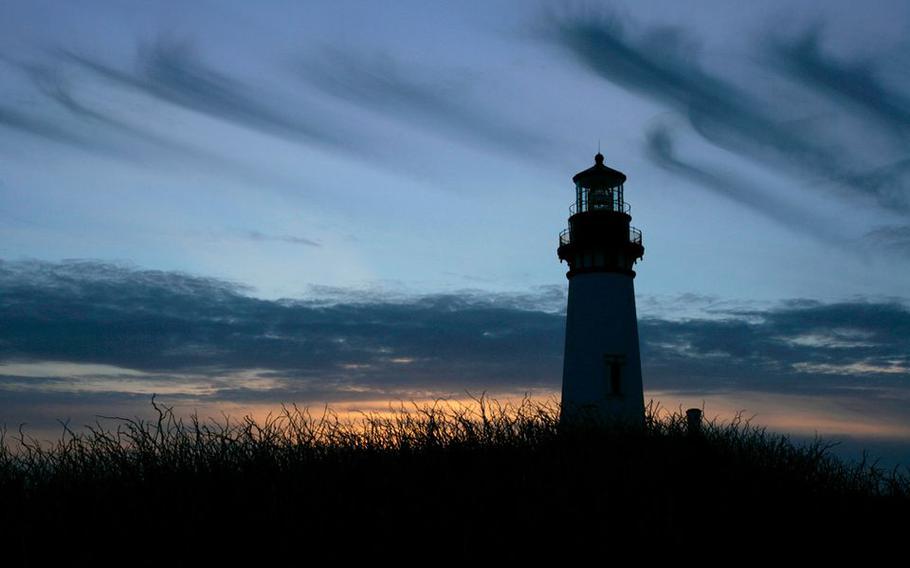
The Yaquina Head Lighthouse in fall, at the Yaquina Head Outstanding Natural Area in Newport, Ore. (Jamie Hale, The Oregonian/TNS)
(Tribune News Service) — When the Yaquina Head Lighthouse was lit for the first time in 1873, its purpose was to let mariners know where they were — a milepost of sorts at sea. Today, thanks to technology, a tower of light is hardly needed to show the way. And yet, Yaquina Head is not only a much loved fixture of the Oregon coast, but a relevant one, both an icon of navigational aid and a monument to another time.
“What were once reference points on the marine highway, are now reference points on the human highway,” said Jay Moeller, chief park ranger at the Yaquina Head Natural Outstanding Area from 2002 to 2021. “It’s like an anchor in time. We can reflect upon how we have personally and as a society navigated changes in technology and cultural values over the past 150 years.”
This month, the U.S. Bureau of Land Management (BLM) will celebrate the anniversary of the lighthouse with numerous events and a public free day.
At 150 years old, the 93-foot-tall tower represents a time when the Oregon coast was sparsely populated, but attention to detail and design was a priority. In the book “Instructions to Light-Keepers,” lighthouse staff were given rules of behavior, instructed to be “Brave, clean, honest, thrifty,” Moeller said. They were required to wear uniforms and given a code of ethics, “The utmost neatness of the buildings and premises … demanded.”

Yaquina Head Lighthouse at Yaquina Head Outstanding Natural Area, Newport, Ore. (Terry Richard, The Oregonian/TNS)
“When it was built in the 1870s, the lighthouse was built on the edge of civilization in the middle of nowhere,” Moeller said. “Public buildings were a work of art. They put up all these Victorian things like the corbels, the filigree on the handrail that goes up the stairs, the way the marble was laid into the floors. On the exterior of the lighthouse, you can see how they did the brickwork to make this ornate framework around each window. When people built public things in the Victorian era, there was an emphasis on aesthetics and integrity.”
Funded by a $90,000 U.S. Congress appropriation (about $2.5 million today), the Yaquina Head Lighthouse is a seacoast lighthouse. As determined by a U.S. Survey in 1850, seacoast lighthouse lamps were required to be 150 to 200 feet above sea level and feature a first-order Fresnel lens, usually about 9-feet tall with “a beam reaching 20 miles in an arc,” Moeller said. Seacoast lighthouses were set about 40 miles apart on the Oregon coast so that “a ship going along the seacoast would always be in sight of a lighthouse, either the one behind It or the one coming up next.” By Moeller’s analogy, seacoast lighthouses were guideposts on the marine highway; the smaller lighthouses, known as harbor lighthouses, the exit signs into port.
The lighthouse we know today isn’t quite the lighthouse it once was. It wasn’t initially called Yaquina Head Lighthouse, but Cape Foulweather Lighthouse or Cape Foulweather Lighthouse at Yaquina Point. Its light was a single fixed white beam fueled at various times by lard or mineral oil and later, oil vapor. In the early 1930s it was converted to electric and in 1939, changed from a fixed beam to the pattern it still flashes today — two seconds on, two seconds off, two seconds on, 14 seconds off.
Its looks have changed, too. Windows were bricked over, then unbricked, the top was painted red for a time, then changed back to the original black, the lighthouse keepers’ dwellings were torn down. The last lighthouse keeper left Yaquina Head in 1969, three years after the lighthouse was automated. In 1980, the Yaquina Head Outstanding Natural Area was established, and 17 years later, the Yaquina Head Interpretive Center opened.

The Fresnel lens in 2007 inside the light tower looking south. (Sol Neelman, oregonlive.com/TNS)
In 2005, the lighthouse was closed for a $1 million restoration project that involved scraping off 134 years of paint, then returning it to its original colors: white tower, black roof and gray trim.
During that restoration, rangers made an interesting find when they removed paint from the brass work around the lens’ pedestal and discovered a hidden compartment that was screwed shut. “There were many guesses about what might be inside,” Moeller said. “When the panel was eventually opened it contained a small wooden dipstick with markings that indicated it was likely used to measure lard oil in the original lamp’s lard oil tank, and also, a cigarette, half-smoked, with lipstick on one end.”
It was shortly after the restoration that the U.S. Coast Guard, which owns the lens — BLM owns the tower — raised the possibility of replacing the Fresnel lens with a “modern optic” so that the Fresnel could be preserved in a museum. At the time, it was one of only 12 first-order — the biggest and brightest of the six orders — Fresnel lens still in operation in the country. In response to the suggestion, Joe Ashor, manager of the Yaquina Head Outstanding Natural Area, said, “Without the lens the lighthouse is little more than a glorified chimney. If you remove the historic lens from the tower, you lose what amounts to the soul of the lighthouse.”
The Fresnel lens stayed and in 2018 a new LED lamp was installed making Yaquina Head only the second lighthouse in the country to receive the newly designed light. The first was at Eatons Neck in Long Island.

The Yaquina Head Lighthouse during an April sunset in 2007. (Sol Neelman, oregonlive.com/TNS)
“It’s a very cool lens,” said Katherine Fuller, education specialist at Yaquina Head Outstanding Natural Area, noting that tours up the 114 steps to the top of the lighthouse have been halted in recent years. “I do hope we return to giving tours to the top, but I would guess it would be in a very calculated manner,” Fuller said. “I don’t think we’ll ever go back to taking hundreds of people a day through the lighthouse. That was way too many, too hard on the structure and the staff, as well.”
While some visitors are disappointed the climb to the top is not an option, it doesn’t seem to have stopped them from coming. In 2022, 453,293 visitors made the mile-long journey out the peninsula to the lighthouse and surrounding area.
“When I started in 2008, visitation was very much centered from late June through early September,” Fuller said. “I’ve seen that expand. Once spring break hits in March, it starts and never really slows down. If the tide is out, they want to go to Cobble Beach. If it’s a rainy cold day, they want to go to the Interpretive Center. Even in July, we’ve had over 700 people in the Interpretive Center throughout the day. There have been days we’ve had 1,000. That’s a busy day.”
The visitors have changed somewhat too, Fuller said. The lighthouse sees more families who speak English as a second language, and bilingual rangers are on hand to provide the information they need. There are more families who home school their children and more visitors from outside the U.S., but the response from first-time visitors upon seeing the ocean and lighthouse is generally the same. “They are kind of in awe,” Fuller said. “They say, ‘Oh my goodness,’ or ‘I can’t believe this.’”
And, of course, as always, it’s still big with romantics. “Just this morning, I had a call from a guy who wanted to know what it looked like out at the lighthouse, the weather, was there any construction or fences, because he is planning to propose here this week.”
On Aug. 19 and 20, the Bureau of Land Management will celebrate the anniversary of the lighthouse with a series of events, including children’s games, speakers, an art show and a free public day on Aug. 20. Find details at https://www.blm.gov/learn/interpretive-centers/yaquina
©2023 Advance Local Media LLC.
Visit oregonlive.com.
Distributed by Tribune Content Agency, LLC.